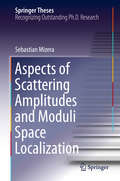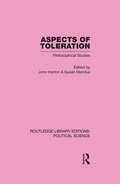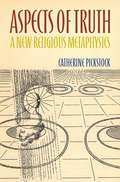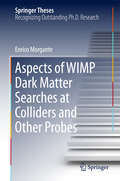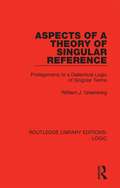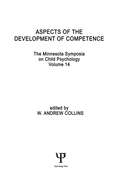- Table View
- List View
Aspects of Scattering Amplitudes and Moduli Space Localization (Springer Theses)
by Sebastian MizeraThis thesis proposes a new perspective on scattering amplitudes in quantum field theories. Their standard formulation in terms of sums over Feynman diagrams is replaced by a computation of geometric invariants, called intersection numbers, on moduli spaces of Riemann surfaces. It therefore gives a physical interpretation of intersection numbers, which have been extensively studied in the mathematics literature in the context of generalized hypergeometric functions. This book explores physical consequences of this formulation, such as recursion relations, connections to geometry and string theory, as well as a phenomenon called moduli space localization. After reviewing necessary mathematical background, including topology of moduli spaces of Riemann spheres with punctures and its fundamental group, the definition and properties of intersection numbers are presented. A comprehensive list of applications and relations to other objects is given, including those to scattering amplitudes in open- and closed-string theories. The highlights of the thesis are the results regarding localization properties of intersection numbers in two opposite limits: in the low- and the high-energy expansion. In order to facilitate efficient computations of intersection numbers the author introduces recursion relations that exploit fibration properties of the moduli space. These are formulated in terms of so-called braid matrices that encode the information of how points braid around each other on the corresponding Riemann surface. Numerous application of this approach are presented for computation of scattering amplitudes in various gauge and gravity theories. This book comes with an extensive appendix that gives a pedagogical introduction to the topic of homologies with coefficients in a local system.
Aspects of Science and Technology in Ancient India
by Arun Kumar Jha and Seema SahayThis book critically examines different aspects of scientific and technological development in Ancient India. It studies the special contribution of the history of science in our scientific understanding and its relationship with the philosophy and sociology of science. The volume: Discusses diverse and wide-ranging themes including Tibetan Buddhist tradition of neuro-biology; Sheds light on the unique developments within iron technology and urbanization in ancient Odisha; Studies the trajectory of proto-historic astronomy in India and the science of monsoon in early India; Evaluates the legacy of Aryabhata based on his major works related to astronomy and mathematics through a multidimensional perspective; Analyses the traditional knowledge of medicine in early India, the golden age of surgery with reference to the ancient Greek and Arabic systems of medicine, and the Buddhist influence on the science of medicine in Tibet. This book will be an essential read for scholars and researchers of ancient history, Indian history, history of science, history of technology, science and technology studies, and South Asian studies.
Aspects of Scientific Explanation: and Other Essays in the Philosophy Of Science
by Carl G. HempelIn this volume address themselves to one or another of four major topics in the philosophy of science, and have accordingly been grouped under the headings "Confirmation, Induction, and Rational Belief," "Conceptions of Cognitive Significance," "Structure and Function of Scientific Concepts and Theories," and "Scientific Explanation.
Aspects of Teaching Secondary Design and Technology: Perspectives on Practice
by Gwyneth Owen-JacksonBeginning by outlining the national curriculum for design and technology, Aspects of Teaching Secondary Design and Technology goes on to look at what design and technology is in the primary school, at examination level and post-16. Vocational qualifications relevant to design and technology are also discussed. There are chapters looking at the relationship between design and technology and the wider social and cultural context. The development of cross-curricular skills and value judgements are discussed as are sustainability and the role of the community in the teaching and learning of design and technology. Together, these articles comprise a sound guide to good classroom practice, related to the requirements of the curriculum, and rooted in the professional perspectives of experienced teachers.
Aspects of Teaching Secondary Geography: Perspectives on Practice
by Margaret SmithThis book provides a practical illustration of the skills, knowledge and understanding required to teach in the secondary classroom. As well as discussing concepts and ideas, the book gives a critical examination of some of the key issues, and will encourage the reader to engage with the ideas and consider their views and beliefs. It is an invaluable resource for those who are learning to teach or for those teachers who wish to reflect on their teaching practice.
Aspects of Teaching Secondary Mathematics: Perspectives on Practice
by Linda HaggartyIf learners in the classroom are to be excited by mathematics, teachers need to be both well informed about current initiatives and able to see how what is expected of them can be translated into rich and stimulating classroom strategies. The book examines current initiatives that affect teaching mathematics and identifies pointers for action in the classroom. Divided into three major sections, it looks at: the changing mathematics classroom at primary, secondary and tertiary level major components of the secondary curriculum practical pedagogical issues of particular concern to mathematics teachers. Each issue is explores in terms of major underpinnings and research in that area, and practical ideas can be drawn from the text and implemented in the reader's classroom practice. Each chapter has been written by a well-respected writer, researcher and practitioner in their field and all share a common goal: to look thoughtfully and intelligently at some of the practical issues facing mathematics teachers and offer their perspectives on those issues.
Aspects of Teaching Secondary Modern Foreign Languages: Perspectives on Practice
by Ann SwarbrickThis lively and inspiring collection of readings is divided into three sections: 'Developing teaching strategies and effective classroom management' covers all major aspects of classroom practice; 'Planning, evaluating and assessing MFL learning' is a guide to the day to day requirements and practicalities of MFL teaching; 'In search of a wider perspective' considers how MFL teaching might develop and expand, and its place outside the classroom. Fully engaged with teaching and learning MFL at a practical level, it illustrates concepts and good practice through a braod range of classroom-based examples and case studies.Issues covered in this book include: maximising potential engaging pupils in their learning developing listening, reading and oral skills use of information communication technology assessment and differentiation broadening the content of MFL lessons role play in the language class MFL beyond the classroom.
Aspects of Teaching Secondary Music: Perspectives on Practice
by Gary SpruceAspects of Teaching Secondary Music provides a practical illustration of the skills, knowledge and understanding required to teach music in the secondary classroom. Musical concepts and ideas are discussed and a critical examination of key issues is given. This encourages the reader to engage with these thoughts and consider their views and beliefs in terms of how they will influence their potential to teach music in an inspired and effective manner.
Aspects of Teaching Secondary Science: Perspectives on Practice
by Sandra Amos Richard BoohanThis book's structure reflects the different dimensions to learning science. The first section focuses on the importance of talk in the science classroom, while the second explores the key role of practical work. The third section is concerned with the creative, theoretical aspect of science. Section four follows this by considering the communication of ideas and how pupils learn to participate in the discourse of the scientific community. Section five emphasizes the place of science in the broader context, considering its moral and ethical dimensions and its place in a cultural context. Finally, section six explores the complexity of the task faced by science teachers, highlighting the knowledge and skills science teachers must acquire in order to create an environment in which students are motivated to learn science.
Aspects of Teaching and Learning in Secondary Schools: Perspectives on Practice
by Hilary Bourdillon Anne StoreyThis textbook heads the Open University's flexible PGCE Perspectives on Practice series, which provides a practical illustration of skills, knowledge and understanding required to teach in the secondary classroom. As well as describing concepts and ideas, the book provides a critical examination of some of the key issues, and will encourage the reader to engage with the ideas and consider their views and beliefs. This book accompanies each of the subject-specific books in the series, providing a valuable link between disciplines. The series complements our other OU series, Teaching in the Secondary School which addresses theoretical issues relating to teaching. Together these to series provide a complete resource for students.
Aspects of Teeside: Discovering Local History
by Maureen AndersonThe Aspects series takes the reader on a voyage of nostalgic discovery through their town, city or area. This best selling series has now arrived, for the first time, in Teesside. Maureen Anderson has highlighted many wonders of the Teesside area, by using the talent of local authors.In Teesside: A Curious Journey the reader will be given the chance to find out the real boundaries of Teesside, an issue that has caused some controversy. We are then taken to the historical site of Stockton Castle: Gone and Almost Forgotten. There is also the chance to investigate the descent of the people of Teesside in Viking Descent: The Bulmers of Wilton-in-Cleveland Castle. We are also shown how important the waterways can be in River Tees: Lifeblood of the Tees Valley. All these and much more, of Teesside's history, have been captivated with fascinating illustrations in Aspects of Teesside.
Aspects of Toleration: Philosophical Studies (Routledge Library Editions: Political Science #41)
by John Horton Susan MendusOriginally published in 1985, these essays relate philosophical questions about the meaning and justification of toleration to debates about such issues as religious freedom, racial discrimination, pornography and censorship. Many take their point of departure from classic works, especially J S Mill’s On Liberty and many consider recent developments in moral and political philosophy.
Aspects of Truth: A New Religious Metaphysics
by Catherine PickstockWhat is 'truth'? The question that Pilate put to Jesus was laced with dramatic irony. But at a time when what is true and what is untrue have acquired a new currency, the question remains of crucial significance. Is truth a matter of the representation of things which lack truth in themselves? Or of mere coherence? Or is truth a convenient if redundant way of indicating how one's language refers to things outside oneself? In her ambitious new book, Catherine Pickstock addresses these profound questions, arguing that epistemological approaches to truth either fail argumentatively or else offer only vacuity. She advances instead a bold metaphysical and realist appraisal which overcomes the Kantian impasse of 'subjective knowing' and ban on reaching beyond supposedly finite limits. Her book contends that in the end truth cannot be separated from the transcendent reality of the thinking soul.
Aspects of Violence in Renaissance Europe
by Jonathan DaviesInterest in the history of violence has increased dramatically over the last ten years and recent studies have demonstrated the productive potential for further inquiry in this field. The early modern period is particularly ripe for further investigation because of the pervasiveness of violence. Certain countries may have witnessed a drop in the number of recorded homicides during this period, yet homicide is not the only marker of a violent society. This volume presents a range of contributions that look at various aspects of violence from the fourteenth to the seventeenth centuries, from student violence and misbehaviour in fifteenth-century Oxford and Paris to the depiction of war wounds in the English civil wars. The book is divided into three sections, each clustering chapters around the topics of interpersonal and ritual violence, war, and justice and the law. Informed by the disciplines of anthropology, criminology, the history of art, literary studies, and sociology, as well as history, the contributors examine all forms of violence including manslaughter, assault, rape, riots, war and justice. Previous studies have tended to emphasise long-term trends in violent behaviour but one must always be attentive to the specificity of violence and these essays reveal what it meant in particular places and at particular times.
Aspects of WIMP Dark Matter Searches at Colliders and Other Probes (Springer Theses)
by Enrico MorganteThis thesis covers several theoretical aspects of WIMP (weakly interacting massive particles) dark matter searches, with a particular emphasis on colliders. It mainly focuses on the use of effective field theories as a tool for Large Hadron Collider (LHC) searches, discussing in detail the issue of their validity, and on simplified dark matter models, which are receiving a growing attention from the physics community. It highlights the theoretical consistency of simplified models, which is essential in order to correctly exploit their potential and for them to be a common reference when comparing results from different experiments. This thesis is of interest to researchers (both theorists and experimentalists) in the field of dark matter searches, and offers a comprehensive introduction to dark matter and to WIMP searches for students and non-experts.
Aspects of War in the Late Middle Ages (Variorum Collected Studies)
by Christopher AllmandThis Variorum collection of articles is intended to illustrate that conflict in the late Middle Ages was not only about soldiers and fighting (about the makers and the making of war), important as these were. Just as it remains in our own day, war was a subject which attracted writers (commentators, moralists and social critics among them), some of whom glorified war, while others did not. For the historian the written word is important evidence of how war, and those taking part in it, might be regarded by the wider society. One question was supremely important: what was the standing among their contemporaries of those who fought society’s wars? How was war seen on the moral scale of the time? The last two sections deal with a particular war, the ‘occupation’ of northern France by the English between 1420 and 1450. The men who conquered the duchy, and then served to keep it under English control for those years, had to be rewarded with lands, titles, administrative and military responsibilities, even (for the clergy) ecclesiastical benefices. For these, war spelt ‘opportunity’, whose advantages they would be reluctant to surrender. The final irony lies in the fact that Frenchmen, returning to claim their ancestral rights once the English had been driven out, frequently found it difficult to unravel both the legal and the practical consequences of a war which had caused a considerable upheaval in Norman society over a period of a single generation.
Aspects of a Changing Social Structure (Routledge Revivals)
by Sir Percy AldenOriginally published in 1937, Aspects of a Changing Social Structure presents lectures delivered in 1936 on behalf of the Sir Halley Stewart Trust. These lectures focus on discussing the interest that government was beginning to take in Britain’s social welfare and industrial patterns. Topics covered include nutrition, child welfare, housing and health in relation to individuals and the state as well as new developments in industrial organisation and the future of the agricultural and coal industry. This title will be of interest to students of Sociology and History.
Aspects of a Theory of Singular Reference: Prolegomena to a Dialectical Logic of Singular Terms (Routledge Library Editions: Logic)
by William J. GreenbergOriginally published in 1985. This study concerns the problem of treating identity as a relation between an object and itself. It addresses the Russellian and Fregean solutions and goes on to present in the first part a surfacist account of belief-context ambiguity requiring neither differences in relative scope nor distinctions between sense and reference. The second part offers an account of negative existentials, necessity and identity-statements which resolves problems unlike the Russell-Frege analyses. This is a detailed work in linguistics and philosophy.
Aspects of symmetry
by Sidney ColemanThis collection of review lectures on topics in theoretical high energy physics has few rivals for clarity of exposition and depth of insight. Delivered over the past two decades at the International School of Subnuclear Physics in Erice, Sicily, the lectures help to organize and explain material that a the time existed in a confused state, scattered in the literature. At the time they were given they spread new ideas throughout the physics community and proved very popular as introductions to topics at the frontiers of research.
Aspects of the Development of Competence: the Minnesota Symposia on Child Psychology, Volume 14 (Minnesota Symposia on Child Psychology Series)
by W. Andrew CollinsPublished in the year 1981, Aspects of the Development of Comptenece is a valuable contribution to the field of Developmental Psychology.
Aspects of the Economic Implications of Accounting (Routledge New Works in Accounting History)
by Gerald H. LawsonFirst published in 1997. Routledge is an imprint of Taylor & Francis, an informa company.
Aspects of the Energy Union: Application and Effects of European Energy Policies in SE Europe and Eastern Mediterranean (Energy, Climate and the Environment)
by Michalis MathioulakisThis book provides a comprehensive exploration of some of the most critical issues regarding the EU’s Energy Union policy. Applied European energy policies face a number of challenges ranging from the geopolitics of energy and energy regulation, to climate change, advancing renewable and gas technologies, and consumer empowerment structures. This book takes a multi-dimensional look into some of these vital issues regarding the European energy sector with a special focus on the effects the Energy Union policy has in two sensitive regional systems, Southeastern Europe and the Eastern Mediterranean.Energy, being by definition a multi-disciplinary field, presents a challenge for readers of any specific disciplinary background that need to grasp an overall understanding of the various aspects of this exciting sector. This book’s objective is to offer the opportunity for readers to get a quality, hands-on overview of the Energy Union by the professionals and academics that interact with it on a daily basis.
Aspects of the Feminine: (From Volumes 6, 7, 9i, 9ii, 10, 17, Collected Works) (Jung Extracts #1)
by C. G. JungExtracted from Volumes 6, 7, 9, Parts I and II, 10 and 17. This collection offers a range of articles and extracts from Jung's writings on marriage, Eros, the mother, the maiden, and the anima/animus concept. In the absence of any single formal statement by Jung on the psychology of women, this work conveys his views on the feminine and on topics that are intrinsic or related.
Aspects of the International Banking Safety Net
by G. G. Johnson Richard K. AbramsDuring the 1970s, international lending by banks came to play a dominant role in the flow of international finance. In the early 1980s, banks have continued to play a major role, but the recent evidence of strains in international banking has raised questions about the prospects for continuity of international intermediation by banks.
Aspects of the Masculine
by C. G. JungThe concept of masculinity was crucial not only to Jung's revolutionary theories of the human psyche, but also to his own personal development. If, as Jung believed, "modern man is already so darkened that nothing beyond the light of his own intellect illuminates his world," then it is essential to show every man the limits of his understanding and how to overcome them. In Aspects of the Masculine Jung does this by revealing his most significant insights concerning the nature and motivations of masculinity, both conscious and unconscious, and explaining how this affects the development of the personality. Offering a unique perspective on the masculine, based upon both his personal and clinical experiences, Jung asks questions that remain as insistent as ever. He offers answers that--whether they surprise, shock or edify--challenge us to re-examine our contemporary understanding of masculinity.
